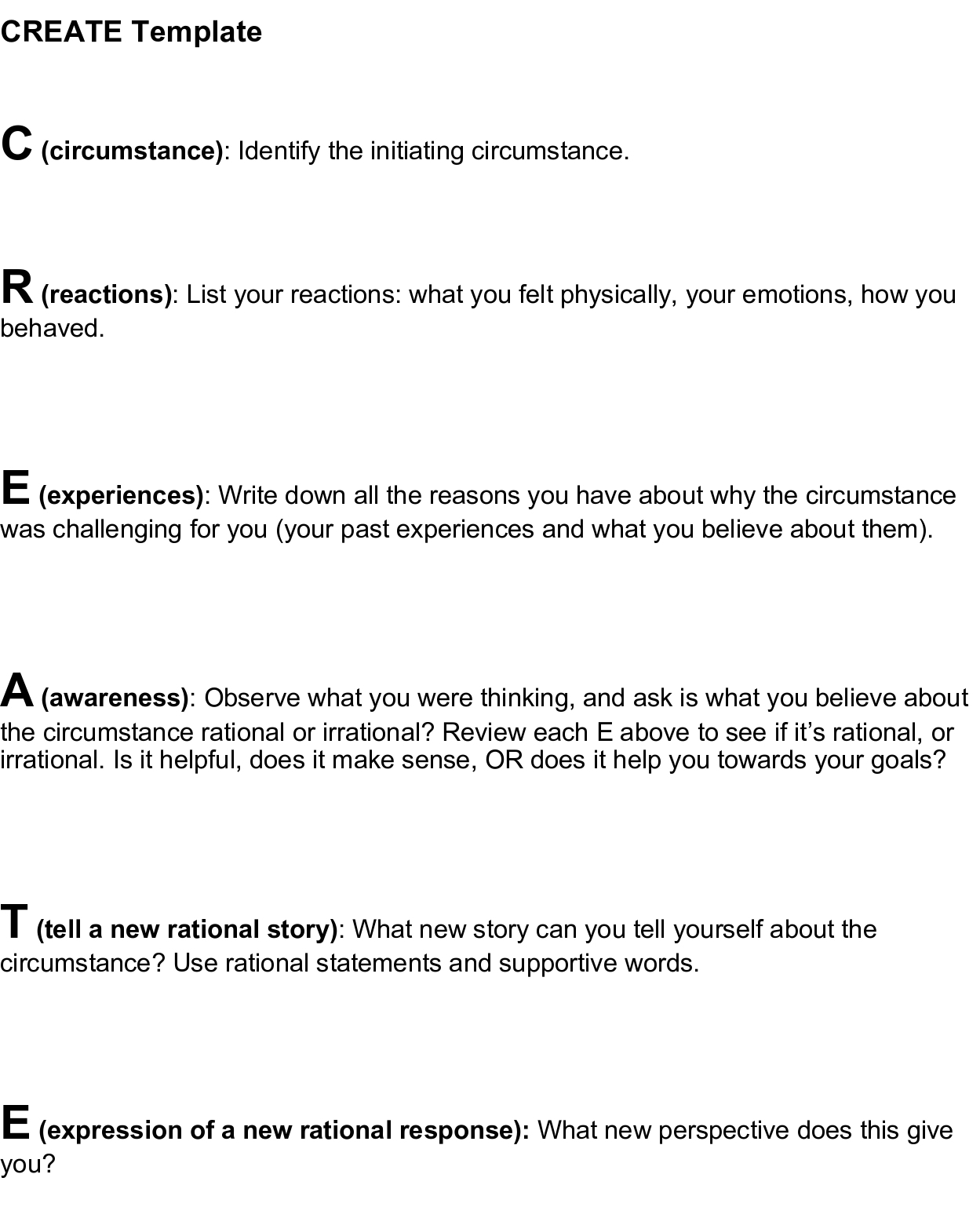 Image by Mystic Art Design from Pixabay
Image by Mystic Art Design from Pixabay
Approx. 5 minute read
Welcome to Part Nine in this series of Practical Tools for Improving Your Mental and Emotional Well-Being.
This article will guide you through a tool called CREATE, which will empower you to CREATE a New Reality that supports your mental and emotional well-being.
This tool can change your life. It can help you change any self-defeating habitual behavior – thoughts, words, or actions – to ones that are healthy and helpful for you.
Your reality is based on how you choose to perceive the world around you (perspectives and beliefs) and how you respond (character, principles, values, behaviors).
CREATE is a simple yet powerful tool for changing human behavior.
The Science
The CREATE tool is based on the scientifically proven ABC process used in Cognitive Behavioral Therapy (CBT)[1] and Rational Emotive Behavioral Therapy (REBT)[2]. Both therapies are well-known, scientifically researched, and respected methods of changing human behavior. CBT and REBT are used extensively by Psychologists, Personal Development Coaches, Counselors, Therapists, Addiction Recovery Centers, and are essential components in the SMART Recovery©[3] program.
The Basics
The CREATE tool helps you change unwanted behaviors to ones you prefer.
It helps you understand why you react the way you do – the beliefs that trigger unwanted emotional states and resulting behaviors. It does this by helping you:
- Identify your undesirable reaction to a circumstance.
- Name the reactive emotions/feelings you experienced.
- Work backward to the initiating beliefs and thoughts about the circumstance that triggered the undesirable outcome for yourself.
- Recognize the pattern of your thoughts and understand that you have the ability to choose what you believe.
A reminder from Part One in this series:

How the CREATE Tool Works
The CREATE acronym stands for:
Circumstance: What happened, is happening, or will happen (triggering event and/or memory).
Reactions – The emotions, feelings, and/or resulting behaviors.
Experiences – Past experiences and current beliefs that support your Reactions.
Awareness – Observe your Reactions. Are they Rational or Irrational?
Tell a NEW story – Change what you believe about the circumstance.
Expression of a new response – More helpful beliefs, emotions, and responses going forward.
The Process
- Pick a circumstance where you want to change your reaction to create a different response in the future.
- Identify the emotions/feelings you experienced (e.g. anger, jealousy, frustration, fear).
- Ask, “What do I believe about the circumstance?”
- Challenge any irrational beliefs.
- Create a different emotional and behavioral outcome.
Example:
One Saturday night you were frustrated and annoyed with the upstairs neighbors in your apartment building because they hosted a party that got very loud.
First, identify the initiating circumstance.
C (circumstance)
- My upstairs neighbors were making a lot of noise.
Next, identify your reactions, how you felt, and what you did.
R (reactions)
- I felt frustrated, annoyed, and angry, and I ended up yelling at them from my apartment and used a broom handle to bang the ceiling, which ended up making numerous indentations.
Identify all the reasons why the circumstance was challenging for you (your Experiences and what you believe).
E (experiences)
- This has happened before, here and in other places.
- People just don’t seem to care about others.
- They don’t understand how the noise impacts me.
- They are inconsiderate.
Now build awareness by asking if your beliefs about the circumstance are rational, or irrational? Review each E above to see if it is rational or irrational by asking if it is helpful or, does it make sense or, is it helping toward your goals?
A (awareness)
- This has happened before, here and in other places – makes sense. So, rational.
- People just don’t seem to care about others – not helpful. So, irrational.
- They don’t understand how much this impacts me – this thought doesn’t help my desired outcome. So, irrational.
- They are inconsiderate – This is a generalization and does not help with my goal of becoming more emotionally aware. So, irrational.
Overall, the E’s (experiences, beliefs) are irrational.
CREATE a new story about the circumstance and reactions that will lessen the emotional charge. Use rational statements and supportive words.
T (tell a new rational story)
- It is impossible for it to be quiet all the time in an apartment building.
- The neighbors above me are quiet the majority of the time.
- I was really tired and the noise was bothering me more than usual.
- I could go for a walk or put my headphones on and listen to some soothing music if it happens again.
- I have met them, they seem to be nice and do not seem to be the type of people to do this maliciously.
- This is a good reminder for me to make sure I’m being respectful of the people below me.
- I could politely ask them to keep the noise level down the next time they are having a party and let them know that I can’t sleep because of the noise (the impact on me).
Now express different perspectives (rational responses).
E (expression of a new rational response)
- I now feel less frustrated and annoyed, I feel calmer and more accepting.
Here is a CREATE Tool template.

The CREATE tool will not make a triggering situation disappear. However, it allows you to gain control over your emotional reactions and to choose a more beneficial response.
An example is to think of it as “dialing down” anger from a raging ten out of ten, to a five out of ten. You become calmer, righteously indignant, instead of raging with anger. Dialing down the emotional charge provides you the opportunity to respond rationally instead of irrationally (and emotionally).
CREATE is a powerful tool for emotional self-regulation.
You can use the CREATE tool for any circumstance and resulting behavior that isn’t beneficial for you. Examples include:
- Stopping problematic behaviors like smoking, gambling, gaming, drugs, or drinking.
- Creating more acceptance in your life for those who “push your buttons”.
- Dealing with challenging events in your life that you have no control over.
- Reducing/eliminating habitual self-deprecating thoughts.
How quickly does it work?
It takes years to create deeply entrenched unhelpful habits and beliefs. It will take time to CREATE different subconscious ways of behaving (new habitual ways of thinking and responding).
CREATE is not a quick fix, but it is something that can be used anywhere and anytime. You can use CREATE after a triggering circumstance (to learn from it), or before (to prepare for one).
By creating awareness of what you believe, and why, you will be more cognizant of alternate beliefs and thoughts for your mental and emotional well-being. Remember, to CREATE any successful long-term change takes practice, patience, and persistence.
Don’t react, respond. CREATE a New Reality for yourself.
Here is the link to Part 10 in this series: A More Peaceful You.
For a free copy of a comprehensive PDF workbook on these tools and concepts, send me an email at [email protected].
I look forward to your comments and feedback.
For more techniques and tools for your mental and emotional well-being, check out my unique and engaging self-improvement novel, The Shift Squad.
________________________________________________
1 Cognitive Behavioral Therapy (CBT):
- https://www.nhs.uk/conditions/cognitive-behavioural-therapy-cbt/
- https://beckinstitute.org/about-beck/team/our-history/history-of-cognitive-therapy/
2 Albert Ellis, founder of Rational Emotive Behavioral Therapy: https://albertellis.org/rebt-cbt-therapy/
3 SMART Recovery©: https://www.smartrecovery.org/
 I write to inspire others to greater self-empowerment, authenticity, and improved emotional and mental well-being.
I write to inspire others to greater self-empowerment, authenticity, and improved emotional and mental well-being.
I am the author of the unique personal development novel The Shift Squad.
If you like what you read please subscribe for updates, share my articles with others, and add your comments below.
You can connect with me via email at [email protected] , on Facebook, Twitter, and LinkedIn.
Be Empowered. Make Authentic Choices And Enhance Your Quality Of Life.
